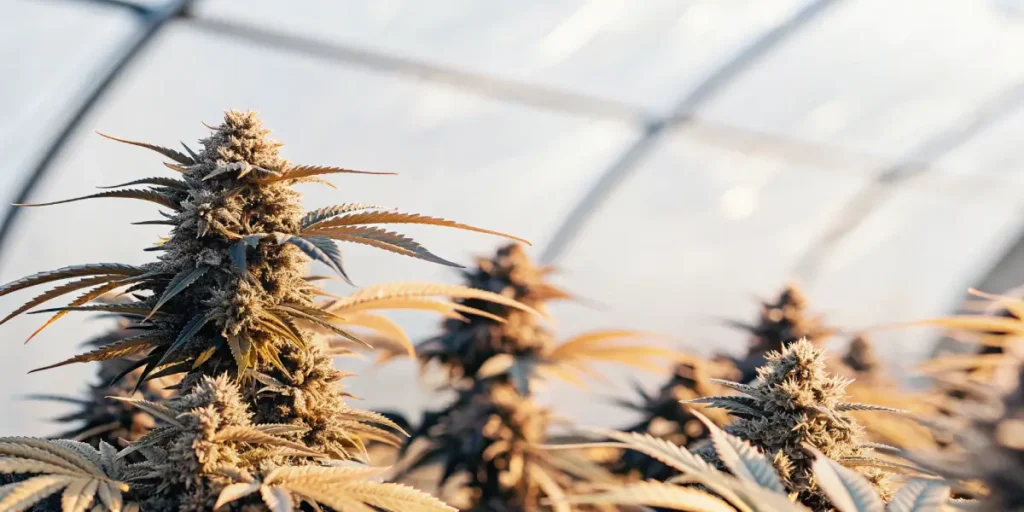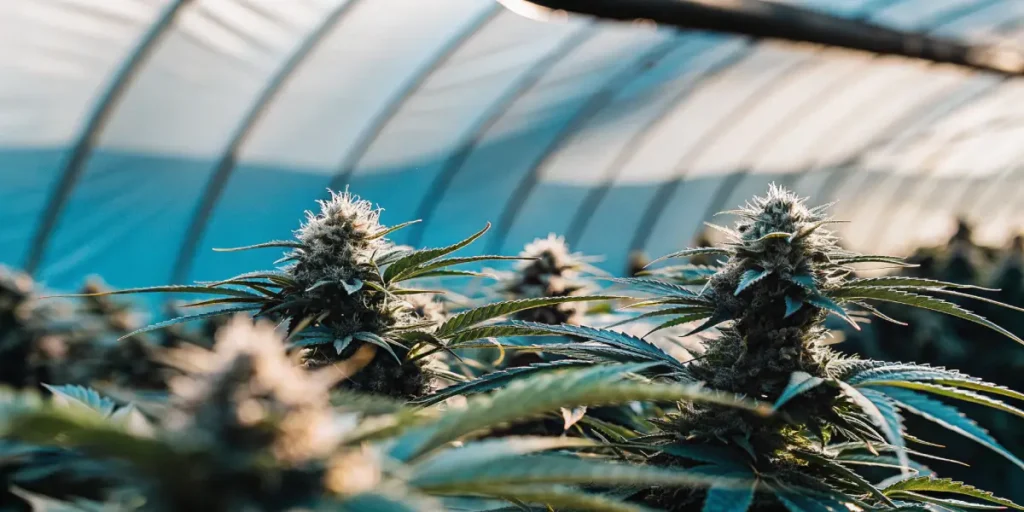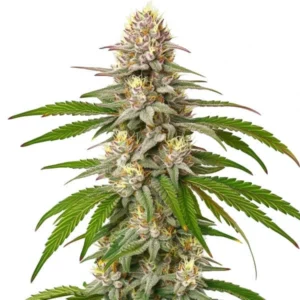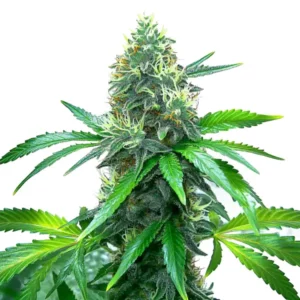
Enzymatic Processes in Cannabis Aroma
Cannabis aroma, that delightful scent you experience, stems from complex enzymatic processes. These tiny proteins are the unsung heroes behind the distinctive smells of your favorite strains. Enzymes essentially act like skilled chefs, mixing and matching compounds to develop unique aromatic profiles.
In cannabis, enzymes play a crucial part in terpene synthesis. Terpenes are aromatic compounds responsible for those earthy, citrusy, or pine-like scents. The enzymatic role in cannabis terpene synthesis isn’t just science talk. It’s the magic behind why one strain might smell like a pine forest and another like a basket of lemons.
Recommended Strains
Sour Diesel
|
|
THC | 22% - 25% (Medium) |
|
|
Type | Feminized |
|
|
Yield | High |
|
|
Phenotype | 30% Indica / 70% Sativa |
Pineapple Express
|
|
THC | 18% - 22% (Medium) |
|
|
Type | Feminized |
|
|
Yield | Medium |
|
|
Phenotype | 40% Indica / 60% Sativa |
Enzymatic pathways influencing cannabis scent vary across strains. This is why a strain like Sour Diesel from Blimburn Seeds can have such a distinctive fuel-like aroma. The enzymes involved in cannabis aroma biosynthesis ensure each plant’s scent is as unique as its fingerprint.
How Enzymes Work in Cannabis Aroma Development
Enzymes are biological catalysts. They speed up chemical reactions without being consumed in the process. In cannabis, they accelerate terpene production, influencing the aroma we all love. Enzyme activity in cannabis terpene production is why you get consistent scents every time you open a bag of your favorite strain.
The impact of enzymes on cannabis aroma development is significant. They interact with various substrates, or starting materials, to produce terpenes. These terpenes then combine in countless ways to create the signature scent of each cannabis plant. For instance, the Mango Haze strain from Blimburn Seeds boasts a fruity aroma, thanks to its specific enzymatic processes.
Furthermore, enzymes are incredibly efficient, ensuring that biochemical reactions occur at rates that support the plant’s growth and aromatic profile. This efficiency is crucial in maintaining the plant’s health and optimizing the enzymatic processes in cannabis aroma, which ultimately contributes to the plant’s appeal.
Another key factor is that enzymes can operate under mild conditions, which helps preserve the integrity of other plant compounds. This characteristic is vital for maintaining the balance of various aromas and flavors that make each cannabis strain unique. Enzymatic activity is thus not only a catalyst but a protector of the plant’s aromatic identity.
Enzymatic Pathways in Cannabis Terpene Synthesis
Enzymatic pathways are like roadmaps. They guide the production of terpenes in cannabis plants. Specific enzymes take charge of different pathways, leading to the formation of various terpenes. Each pathway has its own set of instructions, much like a recipe, ensuring the right scents are produced.
In these pathways, enzymes convert basic molecules into complex terpene structures. The enzyme activity ensures that these transformations happen quickly and efficiently. This efficiency is crucial, especially for growers looking to maintain consistency in their crops.
These pathways are influenced by both genetic and environmental factors, which means that growers have some control over the final aromatic output. By knowing the enzymatic pathways influencing cannabis scent, cultivators can make informed decisions about strain selection and cultivation techniques.
Moreover, research into these pathways continues to reveal new insights into how specific enzymes contribute to the vast array of cannabis aromas. This ongoing study is essential for developing new strains with targeted aromatic profiles and for enhancing the overall sensory experience for consumers.
Practical Implications for Growers
Knowing enzymatic processes can help growers enhance the aroma profiles of their cannabis plants. By managing environmental conditions such as temperature and humidity, growers can influence enzyme activity. This, in turn, can lead to more robust and desirable scents.
Growers interested in specific aromas can also select strains with known enzymatic profiles. For instance, if a grower is aiming for a piney aroma, selecting strains with enzymes that favor pinene production is key. Strains like Pineapple Express from Blimburn Seeds are popular choices for those seeking a tropical, pine-like scent.
Additionally, growers can implement strategies to optimize enzymatic processes in cannabis aroma, such as using organic fertilizers that promote healthy enzyme activity. This approach not only enhances the aroma but also supports sustainable cultivation practices.
Furthermore, by tracking the development of aromas throughout the growth cycle, growers can better understand how different factors impact the enzymatic role in cannabis terpene synthesis. This knowledge enables them to refine their techniques over time, leading to improved quality and consistency in their harvests.
Promos & Deals
Enhancing Enzymatic Activity
Enhancing enzymatic activity in cannabis plants can lead to stronger aromas. One effective method is optimizing nutrient availability. Enzymes require certain nutrients to function efficiently, much like a car needs fuel. Ensuring that plants receive the right balance of nutrients can maximize enzyme efficiency.
Another factor is light exposure. Enzymes in cannabis are influenced by light cycles. Growers can play with light exposure to boost enzyme activity, thereby enhancing the aroma of their plants. This is particularly relevant for indoor growers who have control over lighting conditions.
Moreover, maintaining a stable and optimal environment reduces plant stress, which can otherwise inhibit enzyme function. By minimizing stressors, growers can ensure that enzymes involved in cannabis aroma biosynthesis operate at peak efficiency, contributing to a more pronounced aromatic profile.
Implementing regular monitoring and adjustments based on plant health is also crucial. By observing how plants respond to various conditions, growers can fine-tune their strategies to enhance the impact of enzymes on cannabis aroma development, ensuring a rich and appealing scent in the final product.

FAQs about Enzymatic Processes in Cannabis Aroma
What are the main enzymes involved in cannabis aroma biosynthesis?
The main enzymes involved in cannabis aroma biosynthesis include terpene synthases. These enzymes are responsible for converting simple molecules into complex terpenes, the compounds that give cannabis its characteristic aroma. Different terpene synthases lead to the production of different terpenes, each contributing to the unique scent of a strain.
For instance, the synthase responsible for limonene production will lead to citrusy smells, while another might produce pinene, resulting in a pine-like aroma. These enzymes work in a complex network, ensuring that each cannabis plant has a distinct aromatic profile depending on its genetic makeup.
Knowing the specific functions of these enzymes allows researchers to explore new breeding techniques aimed at enhancing desirable aromatic traits. This knowledge can lead to the creation of novel strains with unique scent profiles through selective breeding and biotechnological approaches.
Additionally, the study of enzymatic processes in cannabis aroma provides valuable insights into the broader chemical ecology of plants. By examining how these enzymes function, scientists can better understand plant interactions with their environment and potential applications in other fields such as medicine and perfumery.
How do environmental factors affect enzyme activity in cannabis plants?
Environmental factors such as temperature, light, and humidity significantly affect enzyme activity. High temperatures can increase enzyme activity, leading to more rapid aromatic development. However, too much heat can also cause enzymes to denature, losing their function.
Light is another crucial factor. Enzymes often respond to the light cycle, with certain activities increasing during daylight hours. Humidity also plays a role; excessively dry or damp conditions can stress plants, impacting enzyme efficiency and, consequently, aroma production.
Beyond these factors, soil quality and nutrient availability also play a vital role in enzyme function. Poor soil conditions can limit enzyme activity, reducing the plant’s ability to produce robust aromatic compounds. Ensuring optimal soil health is thus essential for maximizing the potential of enzymatic processes in cannabis aroma.
Furthermore, external stresses such as pest infestations or disease can negatively impact enzyme activity. By employing integrated pest management and maintaining plant health, growers can protect the enzymatic pathways that contribute to the desired scent profile of their cannabis plants.
Can enzyme activity be manipulated to create specific aromas?
Yes, enzyme activity can be manipulated to some extent to create specific aromas. By selecting strains known for certain enzymatic profiles, growers can predict the resulting aroma. Additionally, adjusting growing conditions such as nutrients, light, and temperature can enhance or inhibit certain enzymatic pathways, allowing for some control over scent production.
However, it’s essential to recognize that genetics play a significant role in determining enzyme presence and activity. While manipulation can enhance certain aspects, the inherent genetic makeup of a strain will largely dictate its aromatic potential.
Experimental manipulation of enzyme pathways through genetic engineering is a frontier in cannabis cultivation. This approach could allow for precise control over enzymatic processes in cannabis aroma, leading to customized aromatic profiles that cater to specific consumer preferences.
Moreover, biotechnological advancements may soon enable the development of enzyme inhibitors or activators that selectively enhance or suppress particular aromatic compounds. This could revolutionize the way we approach cannabis breeding and cultivation, providing unprecedented control over scent characteristics.
Are there any strains with particularly unique enzymatic processes?
Indeed, several strains exhibit unique enzymatic processes that result in distinctive aromas. For example, the Sour Diesel strain is famous for its fuel-like scent, a result of specific enzymatic pathways favoring certain terpenes. Likewise, Mango Haze is known for its fruity aroma, attributed to its unique enzymatic activity promoting the production of myrcene and other fruity terpenes.
These unique profiles make such strains highly sought after by both recreational users and growers interested in specialized cultivation. Selecting these strains from reliable sources like Blimburn Seeds ensures growers receive seeds with the expected enzymatic profiles.
The exploration of these unique enzymatic pathways provides valuable insights into the potential for breeding new strains with targeted aroma profiles. By knowing the enzymes involved in cannabis aroma biosynthesis, cultivators can develop strains that stand out in the market.
Additionally, these distinctive enzymatic processes offer opportunities for further research into how specific terpenes contribute to the therapeutic effects of cannabis. This could lead to the development of strains with enhanced medicinal properties, tailored to specific health needs.
How does enzyme research impact future cannabis cultivation?
Research into enzymatic processes in cannabis aroma opens up new possibilities for future cultivation. Knowing these processes allows for the development of strains with tailored aromatic profiles, enhancing the consumer experience. This research also aids in identifying optimal growing conditions to maximize desired aromas.
Furthermore, enzyme research can lead to more sustainable cultivation practices. By optimizing enzyme efficiency, growers can potentially reduce resource inputs like water and nutrients, leading to more environmentally friendly practices. As our knowledge expands, so does the potential for innovative cultivation techniques that benefit both growers and consumers.
As enzyme research progresses, it will likely lead to the discovery of novel enzymes that can be utilized to enhance not only aroma but also other desirable plant traits. This could result in the creation of multi-functional strains that offer a combination of appealing scents, flavors, and effects.
Moreover, the insights gained from studying enzymatic processes in cannabis aroma can be applied to other agricultural crops, potentially improving the aroma and flavor profiles of a wide range of plant-based products. This interdisciplinary approach holds promise for advancing both the cannabis industry and broader agricultural practices.




















